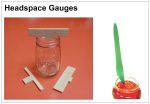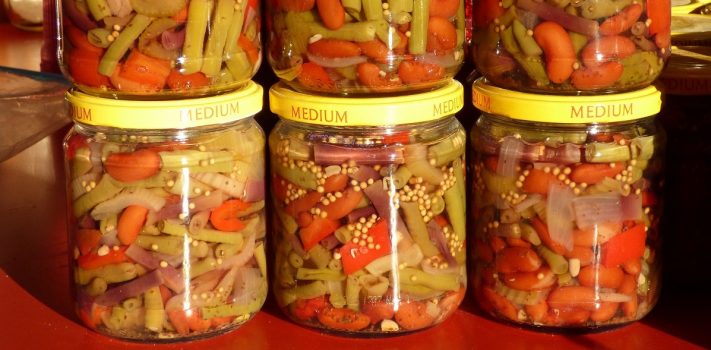I’ve been on an incredible journey since submitting my last article Reusing Canning Jar Lids to SurvivalBlog.
That article was based on my personal experience reusing 1,000+ canning jar lids. Many other home canners bear similar testimony about successfully reusing lids. My article specifically mentioned ignoring all the blogs, the USDA Complete Guide to Home Canning, and even my own experience mentioned in the article. Since the best teacher is personal experience, I then challenged the reader to do a simple test themselves by canning some water with used canning jar lids.
In this follow-up article, I have researched and contacted many of the professionals involved in recommending home-canning procedures including the USDA and Newell Brands, the company which makes Ball, Kerr, Golden Harvest, and Bernardin Jars. I’ve also gone straight to the horse’s mouth and contacted many glass-jar manufacturers and suppliers, engineers, makers of the plastisol sealant used on virtually all of today’s food jar lids, and the FDA’s regulation book for commercial canners, among others.
I believe this is possibly the most comprehensive article on the subject of reusing canning lids and commercial jars which pickles, salsa, pasta sauce, etc. come in. This is a science-based, informative treatise concerning all aspects of reusing canning lids and commercial jars. I hope this article, for some at least, will be the one to finally end all the “controversy” about reusing these items.
TYPES OF INFORMATION AVAILABLE ON REUSING CANNING LIDS
There are two main sources of canning information available: advice from professionals like the USDA and Ball (and the many bloggers and county-extension offices quoting them), and personal testimonies. Personal testimonies were discussed in the previous article. This article first discusses recommendations by the USDA and their close associate in home canning, the National Center for Home Food Preservation (NCHFP), then takes a look at the science behind jars and lids.
Since nearly every article mentioning not reusing canning lids refers back to one of the above two organizations, let’s examine their advice.
IMPORTANT CLARIFICATIONS
First, a few clarifications:
“Commercial jars” refers to jars and their lids from store-bought pickles, salsa, pasta sauce, etc. Please note my references in this article for reusing commercial jars are for water-bath canning only, not pressure canning which I have not tried. The reasons will be explained in more detail in the section on canning lid shelf life.
Incorrect terminology – The words “botulism” and “unsafe” have no place in discussions of reusing canning lids and commercial jars. These terms are used by people who don’t understand the science and principles behind canning. Botulism in home canning results from two things: pressure canner temperatures not reaching 240-250°F for the specified time period, and water-bath canning foods which are not acidic enough. Therefore, whether lids are new or used has nothing to do with botulism. The concept of “unsafe” is also irrelevant to the discussion. New and used lids can fail to seal when canning principles are not strictly adhered to but that does not make the contents unsafe. Home-canned food is only unsafe when unsealed jars are not either put into the refrigerator or reprocessed.
Jar lids don’t fail, humans do. When canning-jar lids don’t seal it’s due to human error, not new- or used-lid problems. Lid problems should be caught by the user beforehand by inspecting each new or used lid. Photo 1 (below) shows a few things which make lids unusable for canning.

Food particles on the rim and incorrect headspace are the two biggest culprits when lids fail to seal, both due to human error. Not wiping the jar rim before putting the lid on can trap food particles between the sealant and the rim, preventing a proper seal. When I’m canning thickened foods like jam, chili, and pasta sauce, it generally occurs when I’m moving the funnel from the just-filled filled jar to the next empty one. To be sure they seal I wipe the rims with a paper towel, then do a visual inspection.
Incorrect headspace can cause an insufficient vacuum to form, the very vacuum which holds the lid on and prevents spoilage. Some home canners don’t realize different foods have different headspace requirements and they leave ½” on all canning items. With insufficient headspace, as the food heats and expands in the canner, food particles are often carried out onto the rim causing the seal to fail. If the headspace is correct but trapped air was not removed with a spatula from jars of sliced carrots, apples, etc., the air will rise to the top of the jar once in the canner and increase headspace, sometimes causing lid failure.

It’s very important to follow all canning-recipe instructions to the letter. If the instructions say to sing the Marines’ Hymn while filling the jars, then I sing! Using a headspace measuring gauge (Photo 2) will assure you get the correct headspace. The DIY type on the left helps avoid using the wrong tab on the commercial gauge in the heat of the moment. Be sure to follow the specific canning recipe instructions but generally speaking, meats and vegetables need 1” of headspace, acid foods like tomatoes and jams need ½”, and fruit juices and vinegars only need ¼”. The laws of physics determine these numbers and doing otherwise can cause lid-seal failure. Canning times are critical. In water-bath canning, removing the lid and waiting five minutes after turning off the heat is especially important and must be adhered to. If not, the contents of the jar have not cooled sufficiently yet, just a few degrees, to begin the vacuum-forming process and siphoning can occur, causing seal failure.
In the Ball Complete Book of Home Preserving the section called “The Art and Science of Home Food Preservations,” has science-based explanations of why it’s important to do each step correctly. The section “Home Canning Problem Solver” has a list of 18 different ways home canners cause lid-seal failure and how to remedy each one. All 18 are the result of human error, not using old or new lids. Lids don’t fail, humans do. I reread both of these sections each year as a refresher, they’re interesting as well as informative.
Good enough – Finally, during this canning-lid discussion it’s very important to keep in mind there isn’t “good, better and best.” There’s only “good enough, it gets the job done.” As an analogy, a piece of quarter-inch rope works as a leash for a border collie. A piece of three-quarter-inch or one-inch rope would also work but it’s overkill since quarter-inch is good enough. Therefore, with rope leashes there’s “good enough,” not “good, better, and best.” The same applies to canning lids: it’s either good enough to get the job done or it isn’t. It either seals, or it doesn’t. There’s no middle road and no good, better, and best.
OFFICIAL USDA HOME CANNING RECOMMENDATIONS
USDA recommendations in the 2015 USDA Complete Guide to Home Canning list the following seven points about canning jars and lids. I have included the passages verbatim, with bracketed numbers and underlines to emphasize certain points.
From page 1-14: “[1] Most commercial pint- and quart-size mayonnaise or salad dressing jars may be used with new two-piece lids for canning acid foods. However, you should [2] expect more seal failures and jar breakage. These jars have a [3] narrower sealing surface and are [4] tempered less than Mason jars, and [5] may be weakened by repeated contact with metal spoons or knives used in dispensing mayonnaise or salad dressing. Seemingly insignificant scratches in glass may cause cracking and breakage while processing jars in a canner. [6] Mayonnaise-type jars are not recommended for use with foods to be processed in a pressure canner because of excessive jar breakage. [7] Other commercial jars with mouths that cannot be sealed with two-piece canning lids are not recommended for use in canning any food at home.”
I wrote to the USDA and the NCHFP asking whether these conclusions were based on anecdotes, conjecture, or actual science-based experimentation with large sample sizes, controls, and data publishable in a peer-reviewed journal. The NCHFP was quick and courteous with their reply, with a confidentiality notice that I could not quote the email so the following is a summary only:
- There’s been no actual USDA research into reusing canning jar lids or commercial jars and they’ve been unable to find any published research.
- When the USDA Complete Guide to Home Canning was published the conclusions and recommendations were a consensus among food-industry and home-canning experts.
- Cooperative-extension offices in many states agreed there were breakage and lid problems when reusing commercial jars.
- When commercial jars are reused, care must be taken to be sure home-canning lids fit properly.
- The University of Georgia where the NCHFP is located is not currently doing any research which would compile data.
Points 2, 3, 4 & 5 which I numbered from the USDA Complete Guide to Home Canning (not the five NCHFB points in the e-mail above) were not addressed by the NCHFP response to my inquiry, or not addressed adequately enough, so let me discuss those based on speaking with professionals in the jar-manufacturing industry who have data and research, as well as my own observations and experiments.
#2. Expect more seal failures and jar breakage. As mentioned, there’s no data whatsoever to support this claim. Most home canners such as myself who reuse lids and commercial jars have not experienced seal failures and breakage when proper canning procedures are followed to the letter. More on this under point 4 below. As for the NCHFP’s mention that many state cooperative-extension offices caution there are breakage and lid problems when reusing commercial jars, this is circular reasoning since nearly all of them are quoting USDA recommendations.
#3. These jars have a narrower sealing surface. That’s 100% true but also 100% irrelevant. Ball, Kerr, and Golden Harvest jars, produced by the Newell Company, and Anchor Hocking jars, made by the Oneida Group, have flat jar rims. I can’t help but wonder if flat rims are merely a holdover from the days of flat rubber rings before metal lids with a plastisol sealant were invented. Every other jar I looked at, generics with “Mason” on the jar, Chinese generics, as well as commercial jars, has rounded rims that seal just as well as flat-rimmed jars.

Thinking about flat vs. rounded, the opposite seems more logical: rounded rims would seal more deeply and cover more surface area of the rim as illustrated in Photo 3. Notice how each rim has a small shoulder which improves the seal. When I put the flat/rounded question to an engineer in the Redoubt, his succinct answer was, “Rounded is better than flat.” But again, “better” is not better due to the “good enough” principle mentioned above. Both flat and rounded rims seal well enough to get the job done.
For another issue that could relate to narrow jar rims, I consulted the FDA’s regulations for commercial canners, “Guide to Inspections of Low Acid Canned Food Manufacturers: Part 3” and found the following point, emphasis mine:
“Cut-thru: ‘Cut-thru’ is a term used to describe when [the rim] has pushed completely through the gasket compound to the metal coating.” With narrow jar rims, one would think the same possibility of “cut thru” could be a problem for home canners but this is not the case. Machines called steam cappers apply the lids very tightly to commercial jars since they’re not water-bath processed afterward. With home canning, the lids need to be loose enough for air to escape during processing. For this reason the concept of “finger tight” is important, making it impossible for “cut thru” to occur.
One manufacturer mentioned that each type of commercial jar has a specific lid to match it and problems can arise when another lid is used instead.
(To be concluded tomorrow, in Part 2.)










